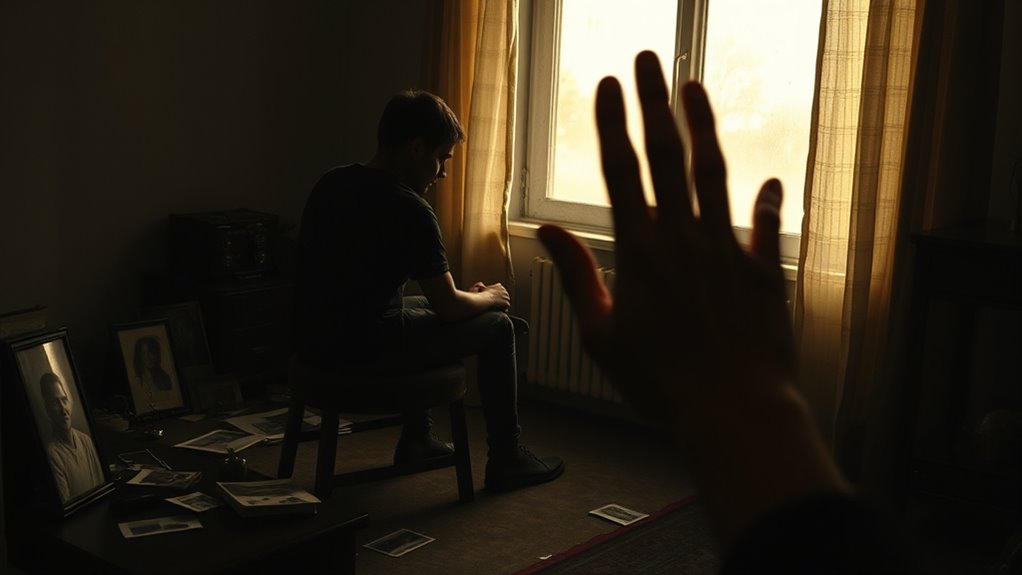Victimology focuses on the experiences of victims and factors that influence crime, like how perpetrators select their targets based on vulnerability and opportunity. Your demographics, lifestyle, and even community safety can affect the level of risk you face. Environmental factors and social dynamics further shape victimization patterns. Understanding these elements is vital for prevention and support. If you explore further, you’ll uncover more insights into emerging trends and effective strategies for combating victimization.
Key Takeaways
- Victimology studies the experiences of victims, societal perceptions, and their support systems to foster empathy and reduce stigma.
- Target selection by perpetrators often focuses on victims’ vulnerabilities, familiarity, or situational opportunities that enhance the chance of crime.
- Individual traits such as age, gender, and lifestyle significantly influence victimization risk, with certain demographics facing unique threats.
- Environmental factors, including neighborhood safety, lighting, and community engagement, play a crucial role in determining crime rates and victimization.
- Psychological theories highlight the impact of emotional responses and resilience factors, shaping victims’ reactions to trauma and their recovery journey.
Defining Victimology: An Overview

Victimology, as a field of study, explores the experiences and impacts of victims in the context of crime and social injustice. It examines how society perceives victims and the often harmful phenomenon of victim blame, where individuals may unfairly hold victims responsible for their suffering. Understanding this dynamic is essential for fostering empathy and reducing stigma. You’ll also learn about the importance of victim support systems, which provide essential resources and assistance to those affected by crime. These supports can include counseling, legal aid, and community outreach, all aimed at empowering victims and aiding in their recovery. By recognizing these elements, you can appreciate the complex reality victims face and the need for compassion in addressing their struggles.
The Role of Perpetrators in Target Selection

Understanding victims’ experiences also requires examining the role of perpetrators in choosing their targets. Perpetrators often have specific motives that guide their selection, whether it’s financial gain, power, or revenge. They assess potential victims based on vulnerability, familiarity, or opportunity, manipulating the target’s environment to increase their chances for success. This target manipulation can take various forms, such as stalking, grooming, or exploiting weaknesses. By understanding these dynamics, you can better recognize the strategies employed by perpetrators and the risks they pose. Awareness of these motives and manipulative tactics is essential in developing effective prevention strategies and support systems for potential victims. Additionally, recognizing the potential for dark circles and puffiness can deepen our understanding of how some perpetrators may exploit their victims’ insecurities. Ultimately, recognizing the role of perpetrators is vital in addressing victimization holistically. Furthermore, their tactics can mirror the way efficient general ledger coding enhances financial reporting accuracy, highlighting the importance of awareness in both contexts. Implementing multi-functional furniture in living spaces can help create environments that reduce vulnerabilities and enhance safety for potential victims.
Factors Influencing Victimization Risk

While many factors can influence the risk of victimization, individual characteristics, environmental conditions, and social contexts play essential roles. Understanding these factors can enhance your risk assessment and help in offender profiling. Consider how personal traits like age, gender, and lifestyle choices can make you more or less vulnerable. Engaging in dynamic communication exercises can also improve interpersonal relationships, which may lower the chances of becoming a target. Additionally, being aware of soulmate angel numbers can provide insights into emotional readiness and personal growth that might impact one’s vulnerability in relational contexts. Regular participation in aquatic exercise can also bolster physical well-being, which may enhance personal safety and confidence. Implementing proper disposal habits can further contribute to a safer environment by reducing the likelihood of accidents or injuries related to neglect. Furthermore, maintaining a high contrast ratio in your home environment can improve visibility and deter potential threats.
| Factor Type | Examples |
|---|---|
| Individual Traits | Age, Gender, Lifestyle |
| Environmental Factors | Neighborhood Safety, Lighting |
| Social Contexts | Community Support, Peer Influence |
| Behavioral Patterns | Routine Activities, Risky Behaviors |
| Situational Factors | Crowds, Isolation |
Psychological Theories of Victimology

As you explore psychological theories of victimology, you’ll discover how individual mental processes and emotional responses can shape one’s experience as a victim. Understanding these factors helps in psychological profiling and enhances awareness of victim perception. Here are four key aspects to consider:
- Cognitive biases – How your thoughts can distort reality and influence your perception of danger. Effective wall organization systems can help reduce feelings of chaos and promote a sense of safety in your environment. Additionally, addressing effective relaxation techniques can further mitigate stress and enhance clarity in decision-making. Recognizing cognitive distortions can aid in understanding how these biases manifest in victimization scenarios.
- Emotional responses – The role of fear, anxiety, or trauma in shaping your reactions to victimization. The aesthetic appeal of certain spaces can influence emotional well-being and contribute to overall resilience.
- Social learning – How past experiences and observations can affect your behaviors and responses as a victim. Understanding how different materials and designs in home decor can create comforting spaces may help in recovery.
- Resilience factors – The personal strengths that can buffer against the psychological impacts of victimization. Additionally, the application of Law of Attraction principles can promote healing and empowerment for victims.
Recognizing these elements can empower you to understand victim experiences better.
Social and Environmental Influences on Victimization

When you consider victimization, it’s important to think about how social and environmental factors play a role. Community crime rates and socioeconomic status can substantially impact your risk of becoming a victim. Additionally, the design of your environment can either protect you or expose you to potential harm. Studies show that optimal angles in community design can significantly enhance safety and reduce vulnerability to crime. Furthermore, understanding the importance of selecting the right strategies in community planning can lead to safer environments and lower crime rates. Incorporating sound design techniques can also create a more inviting and secure atmosphere in public spaces. Engaging in creative practice within communities fosters innovative solutions to enhance safety and resilience against crime. Furthermore, employing AI security solutions can bolster community safety by predicting potential threats and improving response times.
Community Crime Rates
How do social and environmental factors shape community crime rates and influence victimization? Understanding these elements can help you recognize the risks in your neighborhood. Here are four key influences:
- Neighborhood watch programs can deter crime by increasing community vigilance. Additionally, areas with strong investment strategies often see reduced crime rates, as residents are invested in their neighborhood’s safety.
- Crime hotspots often emerge in areas with fewer social connections, making them more vulnerable to illegal activities.
- Lighting and infrastructure quality affects visibility and safety, impacting crime rates.
- Socioeconomic diversity can lead to varying levels of crime; wealth disparities might create tension. Furthermore, areas with strong community engagement often see reduced crime rates, as residents are invested in their neighborhood’s safety.
Socioeconomic Status Impact
Understanding the factors that shape community crime rates naturally leads to examining how socioeconomic status influences victimization. Wealth disparities create environments where those with less economic power are more vulnerable to crime. When you’re in a lower socioeconomic bracket, you might face greater economic vulnerability, which can increase the likelihood of being targeted. This vulnerability can be further exacerbated by fresh lemon juice, which is often unaffordable in low-income neighborhoods, limiting access to health resources that might otherwise help mitigate the effects of stress and trauma. Additionally, individuals in these communities may struggle with auditory processing disorders, which can further hinder their ability to respond effectively to threats or seek assistance.
| Socioeconomic Status | Risk of Victimization |
|---|---|
| High Wealth | Lower Risk |
| Middle Class | Moderate Risk |
| Low Income | Higher Risk |
In these environments, crime often flourishes, as individuals with fewer resources are less able to defend themselves or seek help. Understanding this dynamic is vital for effective prevention strategies. Additionally, creating a sense of community through cozy textiles and local engagement can help mitigate these risks.
Environmental Design Factors
Environmental design factors play a crucial role in shaping the risk of victimization within communities. By understanding these elements, you can better appreciate how your surroundings influence safety. Here are four key aspects to contemplate:
- Lighting Conditions: Well-lit areas deter criminal activities, while dark spaces can invite danger.
- Urban Planning: Thoughtful design can enhance visibility and accessibility, reducing hiding spots for offenders.
- Land Use: Mixed-use developments promote community interaction, fostering natural surveillance.
- Public Spaces: Parks and communal areas that are well-maintained encourage positive social behaviors and discourage crime.
The Impact of Demographics on Target Selection

When considering victimization, demographics play a vital role in target selection. You’ll notice that factors like age, gender, and socioeconomic status can substantially influence who becomes a victim. Understanding these trends helps you recognize the vulnerabilities that different groups face in society.
Age and Vulnerability
As demographics play a crucial role in determining vulnerability, age emerges as a significant factor in target selection for crime. Understanding this can help you enhance your safety. Consider these points:
- Teens often face unique risks due to inexperience and peer pressure, making teen safety a priority in crime prevention.
- Elderly individuals are frequently targeted for scams and elder abuse, as criminals perceive them as less likely to resist.
- Age-related mobility issues can limit escape options, increasing susceptibility.
- Social isolation at any age can heighten risks, as it may reduce the likelihood of receiving help during a crisis.
Gender and Targeting Trends
While various factors influence crime victimization, gender plays a pivotal role in shaping targeting trends. You may notice that certain targeting patterns often reflect underlying gender bias. For instance, women are frequently targeted for crimes like harassment or assault, while men might be more often victims of violent crime. This disparity arises from societal perceptions and stereotypes that shape the offender’s choice of victim. Understanding these dynamics can help you recognize the specific risks associated with your gender. Additionally, acknowledging these trends is essential for developing effective prevention strategies. By being aware of the gender-related factors in victimization, you can better navigate your environment and enhance your personal safety.
Socioeconomic Status Influence
Socioeconomic status considerably influences crime victimization patterns, shaping who offenders target. Understanding this impact is essential, as income disparity and social stratification create environments where certain individuals are more vulnerable. Here are four key ways socioeconomic status affects target selection:
- Access to Resources: Higher-income individuals often have better security measures, making them less attractive targets.
- Neighborhood Characteristics: Areas with high poverty levels tend to experience more crime, increasing victimization risk.
- Social Isolation: Lower socioeconomic groups may lack community support, making them easier prey for offenders.
- Perceptions of Wealth: Offenders may target individuals who appear affluent, regardless of their actual financial status.
Recognizing these factors can help you understand the dynamics of crime and victimization in society.
The Cycle of Victimization: Understanding Recidivism

Understanding the cycle of victimization is essential, especially when considering how it often leads to recidivism. You might find that individuals who become repeat victims are often trapped in this cycle, facing increased vulnerability to future crimes. This victim recidivism can stem from various factors, such as psychological trauma, lack of support, or socioeconomic challenges. When someone experiences repeated victimization, their sense of safety erodes, which can make them more susceptible to future attacks. Additionally, the environment surrounding them may perpetuate these risks, leading to a continuous loop of victimization. Recognizing these patterns is vital, as it highlights the importance of addressing the underlying issues that contribute to being a repeat victim and the broader implications of victim recidivism.
Prevention Strategies for Vulnerable Populations

To effectively prevent victimization in vulnerable populations, you need to focus on community engagement and education. By empowering individuals with knowledge and resources, you can help create safer environments. Awareness programs play a vital role in equipping people to recognize and respond to potential threats.
Empowering Community Engagement
While many communities face unique challenges, empowering residents to engage in prevention strategies can markedly reduce vulnerability to crime and victimization. Here are four ways you can foster community resilience and enhance safety:
- Organize neighborhood patrols: Collaborate with local law enforcement to establish regular patrols in your area.
- Hold community meetings: Create a platform for residents to discuss concerns and share ideas for improving safety.
- Promote local resources: Share information about support services, hotlines, and self-defense classes available in your community.
- Encourage neighborhood watch groups: Foster connections between neighbors to report suspicious activities and build trust.
Education and Awareness Programs
Building on the foundation of community engagement, education and awareness programs play a crucial role in preventing crime, especially among vulnerable populations. These programs help you recognize and respond to various threats, including cybersecurity threats and workplace harassment. By understanding these issues, you can better protect yourself and your community. Workshops and seminars can provide essential skills, such as identifying red flags in online interactions or inappropriate behavior at work. Additionally, awareness campaigns can inform you about reporting mechanisms and available resources. When you’re equipped with knowledge, you’re less likely to become a victim. Empowering yourself and others through education fosters a safer environment and encourages collective action against crime. Together, we can create stronger, more resilient communities.
The Importance of Support Systems for Victims

Support systems play a essential role in the recovery journey of victims, as they provide the necessary emotional and practical assistance needed to navigate the aftermath of trauma. Strong support networks can enhance emotional resilience and help you rebuild your life. Here are some key elements of effective support systems:
- Understanding Friends and Family: They can offer empathy and validation, helping you feel less isolated.
- Professional Counseling: Trained therapists can provide coping strategies and emotional guidance.
- Support Groups: Connecting with others who’ve had similar experiences can foster healing and shared understanding.
- Community Resources: Local organizations can provide practical help, such as legal advice or financial assistance.
Utilizing these resources can empower you to reclaim your strength and move forward.
Emerging Trends and Research in Victimology

As you navigate the recovery process, staying informed about emerging trends and research in victimology can enhance your understanding of the challenges and solutions available. One significant trend is the rise of cyber victimization, which includes online harassment. Researchers are increasingly focusing on the psychological impact this has on victims, highlighting the need for effective support systems. Studies show that individuals experiencing online harassment often feel isolated and powerless, making it essential to address these feelings through community support and resources. Additionally, new technologies are being developed to combat cyber victimization and empower victims. By keeping up with these developments, you can better advocate for yourself and others affected by these modern issues in victimology.
Frequently Asked Questions
How Can I Recognize Potential Victimization in My Community?
To recognize potential victimization in your community, pay attention to environmental cues. Notice areas with poor lighting, overgrown vegetation, or lack of surveillance; these can signal higher risks. Engage with neighbors to discuss safety concerns and create a sense of community safety. When you observe suspicious behavior or individuals loitering, trust your instincts and report it. Staying alert and informed helps you identify vulnerabilities and fosters a safer environment for everyone.
What Are Common Misconceptions About Victim Behavior?
You might think victims always act in a certain way, but that’s a misconception. Victim psychology varies widely, and not everyone shows obvious behavioral cues. Some might appear calm, while others might react with anger or withdrawal. It’s essential to understand that victims can be anyone, and their responses depend on personal circumstances. Don’t assume a lack of visible distress means someone hasn’t experienced victimization; everyone processes trauma differently.
How Does Technology Influence Victimization Risk Today?
Technology considerably increases your victimization risk today. With your digital footprints scattered across various platforms, scammers can easily gather personal information. Online scams have become more sophisticated, targeting unsuspecting individuals through phishing emails or fake websites. You might find yourself vulnerable if you’re not careful about what you share online. Staying informed and vigilant can help you protect yourself from these risks and reduce the chances of falling victim to cybercrime.
Are Certain Professions More at Risk of Victimization?
Yes, certain professions are more at risk of victimization due to occupational vulnerability and specific risk factors. For instance, jobs involving public interaction, like law enforcement or social work, often face higher threats. Similarly, those in high-stress environments, such as healthcare or retail, may encounter increased risks. You should be aware of these dynamics to better protect yourself and implement safety measures tailored to your profession’s unique challenges and environment.
What Resources Are Available for Victims Seeking Help?
If you’re a victim seeking help, various resources are available to support you. Start by connecting with local support networks, like community organizations or hotlines, which can provide emotional support and guidance. You should also explore legal resources, such as victim advocacy groups or legal aid services, to understand your rights and options. Don’t hesitate to reach out; there’s help out there, and you deserve support during this challenging time.
Conclusion
In wrapping up our exploration of victimology, remember that understanding the dynamics of victimization isn’t just an academic exercise; it’s about empowering individuals and communities. Like a phoenix rising from the ashes, victims can reclaim their narratives and build resilience. By recognizing the factors influencing risk and fostering strong support systems, you can help break the cycle of victimization. As we move forward, let’s champion prevention strategies that protect the vulnerable and uplift those who’ve faced adversity.









